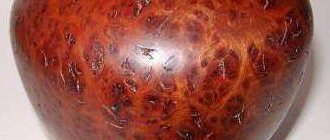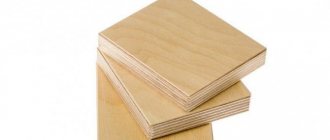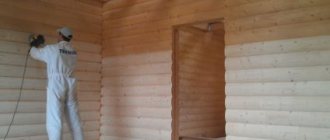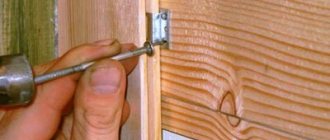It will be interesting to know how to cook a mouth guard for boxing for people who are passionate and professionally involved in this spectacular sport. Cooking lovers can relax; this material is for real athletes and boxing fans. A boxing mouth guard is a device used to protect a boxer's teeth and jaw. Mouthguards for protecting teeth come in 2 types, single and double. The single-jawed one is fixed only on the upper jaw, while the double-jawed one has a hole, which helps to facilitate the athlete’s breathing. If the preparation is carried out incorrectly, then the mouth guard will have weak teeth marks; such a device will not be able to provide good protection.
Processing burl and suveli
You can often see thickenings or growths on the trunks and roots of birch, maple, oak, spruce, pine and some other tree species. These swellings occur as a result of local tissue proliferation. Typically, a distinction is made between beads with a smooth surface (suveli)
, the texture of which on the cut is similar to the texture of Karelian birch, and beads
with an uneven surface (burls)
, the texture pattern on the cut of which is very beautiful and is an intricate interweaving of annual layers with concentric ones scattered here and there circles of the cores of dormant buds. The nature of the formation of both burls and suvels has not yet been clearly defined, but for the master these burls are the most valuable material for work. They are harvested from fallen trees in windfall areas or at sawmills. It is clear that it is easier to separate the influx in the form of a growth from the tree, so in the future we will talk about processing the growths specifically. The latter are cut off with part of the stem wood - then it will be clear what to remove and what to leave. The workpiece is freed from all excess (bark, unnecessary knots), and tar and rot are also removed. Then the workpiece is boiled in a 5% solution of table salt. If the diameter of the workpiece does not exceed 10 cm, boil it for an hour, the duration of such processing of large workpieces increases to 3...5 hours. Boiling is necessary so that the juice inside the wood warms up, is neutralized and the workpiece dries faster. (By the way, the resulting solution can then be used as a beige dye for yarn and fabrics, and by evaporating it, it is even possible to obtain a stain for tinting wood and bone products.)
Next, the workpiece is removed from the solution and, without allowing it to dry, is subjected to pre-treatment. Wet growth wood is quite soft and pliable, and it is also easier to remove any remaining bark from it. At the same time, in the process of drying the boiled workpiece, the likelihood of cracks appearing in its thin walls, if any, is reduced. Once dry, the wood will become hard and will be much more difficult to process.
When starting work, the master must first of all decide which “direction” product (horizontal or vertical) he intends to make from his workpiece. You can't cut from the shoulder here. If the craftsman is going to cut something vertical, for example, a “standing” vase, the workpiece will have to be “positioned”, forming a flat bottom for it. In this case, a workpiece made from a build-up of a typical shape (like a “hedgehog”) will most likely have to be cut across the grain. When working on vases, dishes, boxes, you have to carefully select the “inside” of the future product from top to bottom. Remove excess wood “on a cone” using a drill, an ax, and semicircular chisels. It is not recommended to thin the walls of the product too much, because wood does not like walls that are too thin; the walls, by the way, look even better when they are thick enough.
- Links and examples Examples of finished knives with burl or suveli handles
Introductory information
Many knife lovers or hunters make knives on their own, and most of them order the necessary components from online stores: a blade, a bolster, a butt pad, a block of exotic wood. It’s about the last one, that is, about the tree, that I want to tell you.
I have worked with different types of wood: bubingo, merbao, different types of walnut, beech, ebony... But here we are talking about a completely different type of wood. About our Russian birch burl and suveli. What is it and how to prepare wood yourself for subsequent processing and achieving the final result - a knife handle?
The harvesting method is not new, and I am not the author of the technology described. I gleaned some information from the Internet, and read some from books on artistic wood carving. I simply managed to systematize the experience gained and adapt the technology of drying burl and suveli wood to my conditions.
Suvel is a growth on a tree trunk with a bizarre, intertwined arrangement of fibers.
A burl is a suveli-like growth, twisted in the arrangement of its fibers, from which many small branches also grow. Thanks to this, the structure of the burl acquires not only curliness, but also beautiful rings, stains and wormholes.
With proper processing - drying and impregnation (which will be discussed below) such wood becomes not only extremely beautiful, but also viscous.
How burl and suvel are formed on wood, I cannot say for sure.
In different sources, respected people, experts in their field, put forward different theories, I read quite a lot of them. The first stage
The first stage is reconnaissance, and in the summer, my son and I, walking through the forest, noticed promising trees, from our point of view. The best time for harvesting is September - October
when the movement of juices slows down and almost completely stops.
Required tool:
- bow saw - I use Swedish blades specifically for quick cuts;
- small but very sharp hatchet (600–800 g);
- can of oil paint.
First , use a hatchet to carefully cut the tree bark in a circle.
, going a little onto the burl itself (the operations for preparing suveli are no different),
then we take a bow saw
and begin sawing off the burl.
Since the burl is very viscous, as I mentioned above, you have to cut in shifts and with rest. And this despite the special, very aggressive tooth of the blade, popularly called “wolf tooth”. I once tried domestic and Chinese canvases - summary: if you are not a sadomasochist and do not intend to use this process as a way to lose weight through extreme sweating, then it is better to never use such a tool! ( It’s less labor-intensive and time-consuming to use a chain saw
, but keep in mind that when cutting down a medium-sized piece of wood, the new chain becomes completely
dull. Editor’s note.
)
After the required piece has been sawed off, we position ourselves on a nearby stump and carefully chop off the bark. The main thing here is not to rush, so as not only not to spoil the workpiece, but also not to shorten your fingers in a hurry. The workpiece is spherical and quite nimble.
Cover the cut area on the tree with paint. We took what we needed from the forest, and there was absolutely no point in spoiling the tree.
Moreover, there may be more than one burl on one tree.
For several years we have been cutting down blanks from one tree as needed, and the tree is still alive. Second stage
You have two drying options:
- Natural – burl or suvel dries in natural conditions.
- Cooking in salty solution. This method has been used since ancient times to speed up the drying process.
I always boil my preparations, but here there are several options. You can do it at a fire, but you need to constantly monitor the intensity of the firewood burning (to put it simply, so that the fire doesn’t go out), but it’s better at home on a gas or electric stove. It is important to start cooking quickly. Thus, you will not only finish it earlier, but the workpiece will not crack. Take a suitable container and fill it with water. To begin with, dissolve about 100–150 table salt in water. It all depends on the size of the container and the workpiece (we selected it empirically for a 3-liter container). During the cooking process, which means for 4-5 hours, add water (it should cover the drip) and add two tablespoons of salt when it boils. The water should boil constantly.
During the cooking process, the workpiece must be completely saturated with saline solution. Otherwise, cracking of the wood is inevitable, and all the work will go down the drain. There must be at least 4 cooking sessions at intervals of 24 hours. The fact is that in one cooking session our workpiece cannot be saturated with saline solution. When drying, salt displaces sap and moisture, which is how the wood is express-dried without cracking. In the intervals between cooking, we wrap the caps tightly in newspaper, which we change as it absorbs moisture from the workpiece.
We do the same after the last cooking.
The preparation remains in the newspaper for another three weeks (for those who are itching), or better yet, a month. In the last few days the newspaper will be almost dry. And now our cap is ready. The third stage
is sawing into dimensional pieces, for which you will need a hacksaw with a fine tooth for a “clean saw” and a pair of carpentry clamps. We mark the burl, secure it with clamps and saw it.
You need to secure it thoroughly, because the cap will most likely move slightly after drying. One medium-sized burl produces 3–4 blanks for knife handles. The trimmings are used for the handles of cutlery in the “hunting” style.
A small but important detail.
We dip the ends of the sawn blanks into 2–3 cm of molten wax. This is necessary so that during final drying the blank does not crack, and in the middle part the remaining moisture finds a way out.
The last stage
Well, the last one. There are many ways to impregnate the final product (I mean a ready-made knife with a mounted handle). But in my experience, the best way to impregnate a burl or suvel handle is cooking in a steam bath
in natural beeswax over low heat. I also tried the newfangled carnauba wax, but it can’t compare with our beeswax. With this method, hot wax saturates the handle completely and not superficially within about an hour. The tree acquires transparency, begins to glow from within, and durability.
To emphasize the beautiful grain of the structure, I recommend lightly tinting the wood with a special
stain BALSIN SCHAFTOL from BalistolKlever. This must be done, of course, before cooking in beeswax. The final polishing and gloss is applied with a special wood oil, Danish oil, from Rustins. Three times per day with intermediate drying.
With this treatment, the handle of the knife will serve you for a long time, pleasing the eye and warming the soul - after all, I myself made such beauty
- long years!
Links and examples
Alexander Lopukhov, Prorez magazine No. 2, 2008.
If wood is the most beautiful and most popular natural material, then burls and suveli are a concentrate of this beauty. What an irony: what foresters call “a defect in the shape of a tree trunk” becomes a lucky find for skillful hands that turn suvels and burls into real masterpieces.
Roughing
Before starting work, it is important to decide on the type of future product. If a craft made from birch suvel is vertical (for example, a vase, a candlestick), then it is better to make a cut in this direction and immediately form the bottom of the product. When making a bowl, box, or dish, the inside is selected from top to bottom. Remove excess wood, moving from the walls to the center at an angle of 45°. The best option would be to use a semicircular chisel or drill.
Please note: do not make the walls too thin. When dry, they may become brittle or crack. As a rule, products with sufficiently thick sides look more beautiful, are more durable and last longer.
After preliminary shaping, the wood is left for another 1-2 days outdoors away from direct sunlight (or indoors, again wrapped in newspaper). After this, proceed to the next stage.
Tree burls: what is it?
Wood burl is not only an amazing material from an aesthetic point of view, but also from a botanical point of view. A group of hundreds or thousands of dormant adventitious buds, shaped like tubercles or needle-like growths with a rudimentary ring structure around them, is the cap. Externally, it has the appearance of a rounded growth, or ringing the entire trunk, covered with bark. Sometimes “sleeping” buds can wake up and escape from the burl.
Suvel (left) and cap without bark
Wood burls are characteristic of deciduous trees - linden, birch, oak, aspen, walnut, elm, but in our latitudes the birch burl is most often found. Perhaps the birch burl has the most beautiful structure. It is rare to find burl from coniferous trees.
As for the size of the burl, they can vary from barely noticeable on the trunk, the size of a nut, to one meter and even two meters. Wood burl is a very rare phenomenon, much less common than burl. Although sometimes two or even several burls can form on one tree. The burl grows for a very long time – we are talking about tens of years.
The burl that forms near the root is called basal, or caporoot; that burl that grows on a trunk or branches is a stem burl.
Why does a burl appear on a tree?
A very interesting question to which it is impossible to give a 100% correct answer. – like Chuk and Gek, they are almost always pronounced in pairs. However, they have completely different natures of education.
Option 1.
An adventitious bud appears under the bark, but the tree bark is so hard that the bud does not have the strength to break through it. But the growth mechanism has already been launched; plant hormones and nutrients rush to the site of potential germination, which assist in the appearance of many new buds, which also do not have the strength to break through and, thus, the burl grows.
Maple burl texture
Option 2
. An adventitious bud appears under the bark, but due to mechanical damage - a hurricane, a human hand, an animal - it cannot develop normally. And it develops abnormally, with deformation of the wood structure.
Option 3
. An adventitious bud appears under the bark, but due to spring frosts, viruses, bacteria, fungi, insects, and the specific mineral composition of the soil, the tree feeds not the shoot, but the burl.
Be that as it may, the most interesting thing about wood burl is not its origin, but its texture. Let's talk about her.
Wood burl: texture
The main way that burls and suveli differ from each other is the presence of “eyes” of knots in the burls when viewed in a transverse section. The pronounced core of small branches, together with a curled complex texture, pronounced twisted annual layers, give an incredible, fairy-tale pattern. Moreover, in nature there are no two completely identical mouthguards - neither in shape nor in design.
On a fresh cut, the texture of the burl is faintly visible; it appears after processing - grinding, polishing, toning. At the same time, the texture of the stem burls is thinner and more refined than the root burls.
After processing, the burl resembles stone more - marble, malachite - than wood. At the same time, the material acquires a muted shine and pearlescent shine.
The color of wood burl largely depends on the type of wood and where it was formed. The predominant colors in the burl texture range are brown, milky, pinkish, greenish.
Due to the large number of knots and curls, the burls are difficult to process, but they lend themselves well to grinding and polishing.
Finishing of the product
Since each piece of material is unique in nature, it must be carefully inspected before finishing. Perhaps the knot that you initially wanted to remove will be the highlight of the finished product, for example, handles made from birch suvel.
During finishing, the angularity of the material’s shapes is removed in order to bring it closer to the finished look and reveal the structure of the wood. If during the processing process natural defects or small cracks are revealed, they will have to be repaired with a mixture of sawdust and glue. In the worst case, you will need to deviate from the original idea and modify the product.
After completing the internal and external processing of the suvel, they begin to clean up the roughness. This can be done with a scraper, wire brush, or rasp. Movements should be frequent and small so as not to spoil the material. Finally, grinding is performed with a drill with special attachments. If there is none, it is processed manually with sandpaper; the second option is even more welcome. You need to start with a coarse one (five), then move down to the finest grain size.
The finished product is cleaned of dust and tinted if necessary. If desired, you can varnish the wood, rub it with wax or hot drying oil. The process of working with willows is very long and labor-intensive, which is why products made from it have a high cost. The price of birch suvel varies from 100 rubles. for a processed block measuring 120×40×30 mm up to 200 rubles. per kilogram of sawn raw materials.
Wooden suveli: what is it?
Wood suvel (wood svil) is a round growth on a tree of both deciduous and coniferous species, which consists of twisted, deformed wood fibers. There are suvels girdling the tree around, or groups of several suvels on one tree.
Another difference between suvels and burls is that under the bark of tree suvels there is a smooth surface, sometimes with bumps, but large ones, not “pimples” like burls.
The density of suvels is slightly less than that of burls; therefore, they are a little easier to handle.
How are suveli formed on a tree? As a rule, this is the result of an external influence on the tree, as a result of which a fold is formed. Over time, the fold becomes overgrown with tortuous fibers. Suveli are found on trees much more often than burls.
Wooden suveli: texture
Suveli can have different textures, depending on the intricacy of the structure of the growth, but the predominant figures can be called waves, bends, spots, stripes. After sanding and polishing, the shine and shine of the wood appears.
The color of suvel can be yellow, brown, grey, pinkish or greenish.
Twigs can be stem or root - just like burls. Root suveli are more valuable because of their pronounced, intricately twisted annual rings and dark veins. Stem suvels do not have such a rich pattern, and their wood is lighter in color.
Craftsmen note that after proper processing, wood suvels begin to glow from the inside, like amber. The pattern of the suvels resembles marble.
What not to be confused with?
Beginners who are not very familiar with what birch suvel is may confuse it with burl. By the way, the second one is much less common and is considered more valuable. Their main difference is the presence of knots in a longitudinal cut, a clearly visible core, a fine pattern, and pronounced ornate layers. Moreover, there are no repeating burl patterns in nature; they all have a unique design.
The surface of the suvel under the bark is smooth, less often with large bumps. In burls, it is finely pimpled, and small branches grow from it. Suveli is not so dense and is easier to process.
Mouth guards and suveli: use
The use of burls and suvels is primarily decorative. Of course, they are used to make functional things, but even their main task is to please the eye, and not to be something purely utilitarian.
Rarely used in carvings. Their extremely bright texture “eats” the entire carving. In addition, the carving looks cheap on expensive material. As a rule, craftsmen simply grind the material and impregnate it with oil or varnish it.
Suveli and mouth guards are not used on an industrial scale. Previously, in Russia, more precisely, back in the Soviet Socialist Republic, there were several enterprises whose workers created masterpieces from suvels and caps. Now these unique creations of nature are going, roughly speaking, into the furnace. For foresters, growths are simply a defect in the wood, a defect in the material.
So, what are the types of products made from burl and suvel?
We will conditionally divide them into three groups - decorative products, functional products and veneer.
1) Decorative items made from burl and suvel.
It can even be burl or suvel in its natural form, just without bark and varnished - an excellent decor for an eco-style home.
A special place is occupied by sculptures and figurines, especially those depicting animals. Why animals? The texture of burls and suveli perfectly imitate the plumage of birds, wool or animal skin. In addition, the natural smooth lines of this material themselves suggest what they can become - all that remains is to remove the excess. But mouth guards and suveli are not suitable for depicting human faces, as they give them an unhealthy appearance.
Another product made from burl and suvel is panels. Burls and suveli are such a unique material that it is enough to choose the right tint - and the real picture is ready. However, such material is used in mosaic, marquetry and intarsia.
And, of course, the beautiful texture looks great on hairpins, keychains, pendants, cufflinks and other jewelry. And bowls, vases, stands and candlesticks will give any home a feeling of luxury and real taste.
2) Functional items made from mouthguard and suvel.
This can be small furniture, dishes, boxes, snuff boxes, tool handles, office supplies, lamps, frames, chess, canes, watches and much, much more. Of course, such things fulfill not so much their functional requirements as their decorative ones. Functional items made from suvel and burl say a lot about the excellent taste of their owner.
Cap and suvel. Native exotic.
Sooner or later, when you get involved in the fascinating business of making knives, you want to use something more beautiful on the handle than your native beech, walnut or cherry. Catalogs of stores for knife makers are full of exotic names and photographs of extraordinary beauty and design of pieces of wood. All these “Amboina Burly” are not so cheap...
But even in our northern forests, you can find wood that is hardly inferior in beauty to Australian exotics. We will talk about KAPA and SUVELI.
First you need to decide what is what? Some sources claim that burl and suvel are one and the same. I don't agree with this.
So - cap.
Burl is a rounded growth on a trunk or branch formed by small woody nodules of adventitious and dormant buds. On the surface there can be, and more often than not, many small shoots and twigs. Burls are found mainly on deciduous trees: oak, walnut, maple, poplar, but most often on birch. In the future, this is what we will talk about.
If you're lucky, you can find a branch burl - a kind of ball growing on a thin branch. It is small, like all mouthguards, and, unlike suveli, it has a “needle-like” structure and a very small, pronounced pattern in the form of dots and dashes.
Growths on trunks are more common.
And even more often - the basal burl, the “kaporoot” - it can be very large, but the pattern of this “giant” is not so pronounced and contrasting.
Under the bark of the growth, the surface of the tree is uneven, there are many protrusions in the form of spines and tubercles.
Burl wood is 50 - 70% denser than the wood of the tree itself, the fibers are interwoven, multidirectional, plus a large number of darker inclusions formed by “sleeping” buds, so burl is unusually beautiful both on crafts and on knife handles.
It is difficult to process due to its “twisted” structure, but this gift of nature is worth it.
According to some estimates, 1 tree with a burl accounts for, on average, 3000-5000 ordinary trees without a burl.
Therefore, finding a “worthy” mouthguard is quite difficult... Unlike suveli.
Suvel.
Suvel is formed by overgrown annual rings of a tree. The structure of the growth, as the name implies (also called svil), is twisted, caused by twisted annual rings.
Reaches enormous sizes. In the Vatican there is a font carved from one growth. But, according to my observation, the smaller the suvel, the more saturated its pattern. Under the bark of the growth, the surface is lumpy, but without “spikes”, like on a burl, but in the form of large, smoothly flowing depressions and “hills”. Suvel is well polished, and polished wood impregnated with linseed oil, for example, is very beautiful - it seems to glow from within, the pattern is multidirectional, with a mother-of-pearl tint.
It is also difficult to process, but easier than cap.
IT IS PREFERABLE TO CUTT OUT THE GROWTH DURING THE DRY TIME OF THE YEAR, IDEAL AT THE END OF AUGUST, THE BEGINNING OF SEPTEMBER, BEFORE THE COMMONATION STARTS.
The cut area must be protected - painted over with paint or thick lime.
Craftsmen who create amazing crafts from these gifts of nature know exactly how to dry birch suvel. But you can go into the forest yourself in search of suvel and make an exclusive thing with your own hands.
You need to learn how to dry birch suvel in order to create a wonderful thing from the gifts of nature with your own hands.
Cooking rules
Before cooking a burl, you should carefully study a number of rules that will prevent unforgivable mistakes. So, the rules are as follows:
- If the mouthguard is overcooked, it will have to be thrown away, because an incorrectly prepared product will never return to its original shape. It is still possible to prepare the mouthguard, but it will not be possible to restore the overcooked device.
- When placing the mouthguard in very hot water, it should not be completely immersed. The sports product should simply float on top.
- When clenching your teeth, you cannot move your jaws; you must fix the mouth guard very tightly and wait the required amount of time - 5 minutes.
If the mouthguard is prepared according to the rules, then it:
- will have distinct imprints;
- will adhere perfectly even to the upper teeth;
- will not create discomfort for the athlete.
If you carefully study how to cook kapa correctly, the result will be excellent.
How to dry birch: suvel and drip
Suvel (the second name for svil) is a special growth on the trunk of some trees. It grows faster than the tree itself and sometimes grows to enormous sizes. It received this name because of the interesting twisted patterns that are unique, like human fingerprints or frost patterns on windows, and therefore valuable.
Birch burls are also growths, but they differ from suveli in shape. Suvel has a twisted structure and a relatively smooth surface, and the cap (another name is witch’s broom) grows in the form of a spherical growth of fibers intertwined inside.
Such growths, after preliminary preparation, are used to create jewelry, amulets and medallions, key rings, decorative interior elements and tableware.
You should go into the forest to hunt for exclusive material at the end of summer - beginning of autumn. The best months for this are August and September. There are no recommendations for searching; you need to inspect all suitable trees on your way; “trophies” of this kind go to only the most attentive.
When you find what you're looking for, don't rush to reach for the saw. Look where the growth is located: if it is on the root or wrapped around the perimeter of the trunk, cutting can seriously damage the tree. In this case, it is worth looking for another copy.
Amazing phenomenon
When cutting a birch tree correctly, you can see amazing phenomena. To be more precise, the interweaving of wood fibers forms pearlescent areas with a unique pattern. They begin to emit a special glow when reflected from sunlight. The effect looks very beautiful in finished products, for example, in a stacked handle made of birch suvel.
The pattern and color are distinguished by their uniqueness; as a rule, it is brownish-ocher, soft pink, straw with a pearlescent sheen, and less often - dark brown with a marsh tint.










